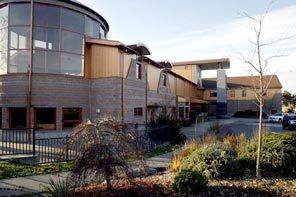Excerpt From an Open Letter to Arne Duncan from Herb Kohl
We have come far from that time in the '60s. Now the mantra is high expectations and high standards. Yet, with all that zeal to produce measurable learning outcomes we have lost sight of the essential motivations to learn that moved my students. Recently I asked a number of elementary school students what they were learning about and the reactions were consistently, "We are learning how to do good on the tests." They did not say they were learning to read.
It is hard for me to understand how educators can claim that they are creating high standards when the substance and content of learning is reduced to the mechanical task of getting a correct answer on a manufactured test." (Summer 2009)
Nova High School Relocated

Merit Pay
Laurie, in response to R. Weingartner, On Point, 1/26/10
Merit pay is an issue that is closely associated with charter schools and is a reiteration of the No Child Left Behind Act.
Basically, it requires that teachers pay be based on how well their students perform on standardized tests. For our students, it could be the new MAP test. With the No Child Left Behind Act, teachers and staff were pressured to teach much of the class work to the standardized tests. With so much focus on the test, many other parts of knowledge building, creativity and understanding of subjects and their synthesis with other knowledge had to take a back seat. For many students, teaching to a test meant that they were not able to reach their full potential which would have been far beyond the level of the tests.
No one wins in this situation.
Part of the fallout also is that if a teacher's pay is based on how well their students test, many teachers will want to teach in a school where they know that the students will perform well. Those schools are, for the most part, not the schools that are predominately minority in population.
Some students do not perform well on standardized tests for many different reasons and yet a teacher's pay can be tied to that student's performance. High stakes testing also puts pressure and stress on the students who become burdened with the thought that they need to perform well on one test. The test becomes a focus with little opportunity to explore and have fun learning, creating and synthesizing new thoughts and ideas.
Update: The Governor of Texas has decided to opt out of the Race to the Top funding because of the ineffectiveness of the merit pay program that was in effect for three years inthe state.
Update: March 8, 2010 Principal to be removed from school in Wasington State due to low WASL scores.
What Is a Charter School?
A charter school can expel any student that it doesn't believe fits within its standards or meets its level of expectation in terms of test scores. If the student is dropped off the rolls of the charter school, the money that was allotted for that student may or may not be returned to the district at the beginning of the next year. That is dependent upon the contract that is established by each district.
Also, according to a recent (June 15, 2009) study by Stanford University's Center for Research on Education Outcomes (CREDO), charter schools do not necessarily perform any better than public schools. In fact, 37 percent performed worse. Forty-six percent demonstrated "no significant difference" from public schools. Only 17 percent of charter schools performed better than public schools.
Thomas Jefferson
The Broad Foundation
The Broad Foundation claims to be a philanthropic organization, created by billionaire Eli Broad.
The Broad Foundation supports privately run charter schools and actively develops a system of charter schools in urban areas.
Broad claims it engages in "venture philanthropy":
"Our Approach to Investing: Venture Philanthropy. We take an untraditional approach to giving. We don't simply write checks to charities. Instead we practice 'venture philanthropy.' And we expect a return on our investment."
Many of us have discovered the Broad Foundation's presence within SPS and are requesting an explanation for why it is here and what its' objectives are.
Seattle has three "Broad Residents", and two Broad graduates now working within SPS. One of them is our superintendent who is a graduate of the Broad Academy which trains superintendents, and is also on the Broad's Board of Directors.
Another Broad graduate and a onetime Broad resident in SPS, Brad Bernatek, is now Director of REA, Research, Evaluation and Assessment within SPS. That department is responsible for student statistics including enrollment, demographics, evaluation and standardized testing.
The Broad Foundation provided Dr. Payzant, also a Broad graduate, to be a part of our superintendent’s yearly review in 2009.
Broad recently gave SPS a $1M "gift." That money is now in the hands of the Alliance for Education and no one knows how the money is being spent.
All in all the Broad Foundation has been quite generous to the Seattle Public School system and as Eli Broad states himself, he expects a return on his investment.
Broad also supports and actively promotes mayoral control of school districts. Eli Broad's preferred model of mayoral control means that the mayor selects the school board members and superintendent who are therefore unelected and are beholden only to the mayor, not the people of the city. It then becomes a school district that is run by one person, the mayor, with heavy influence by the Broad Foundation through developed relationships with that individual.
Update: A Detroit School District employee found accepting money from the Broad Foundation.
"Let the games begin: Detroit Teachers vote to unanimously join the current Detroit Public School District in their suit against Robert Bobb".
Update: The Broad - Rhode Island connection.
Rhode Island has had the dubious distinction of making national news recently for the draconian firing/scapegoating of an entire school of teachers. Is it a coincidence that the new education commissioner for R.I., who is pushing the state to do whatever it takes to qualify for federal "Race to the Top" dollars, is a "Broad Superintendents Academy" graduate, Deborah Gist?
Dan Weil
Dollars and Sense
December, 2009
What the Gates Foundation Is Doing: The MAP Test
The Gates Foundation supports, and pays for, high stakes testing which is tied to merit pay.
The Bill & Melinda Gates Foundation has given Seattle Public Schools a total of $9M this year for additional testing. We have not been able to find out the details of this testing yet. We don't know what the test is, what the test is to determine, who is administering the test and how the results of the tests are to be used.
UPDATE: We have heard that the Gates "gift" is funding the new computerized, standardized "MAP" tests the district is administering this year to all students, from as young as kindergarten to grade 9. MAP stands for "Measures of Academic Progress™" (yes, it is a trademarked product) and will be administered to the kids three times during the school year. The test can take as much as two hours each session, according to the district's official announcement letter.
A number of questions come to mind: Is this the best use of the students' school time? Is it appropriate to make children as young as five who can't read take a standardized test on a computer? Is this the best use of such funds? Or would parents, students and teachers prefer to see money channeled more directly to the classroom, to create smaller class sizes, more enrichment opportunities, or to purchase new textbooks?
A SIDE NOTE: Another interesting connection is that our superintendent, Dr. Goodloe-Johnson, is on the Board of Directors for the company that has created and distributes the MAP test. There is $4.3M in the levy to pay for additional use of this MAP test in Seattle.
The Cooper Building: Program DIscontinued, 2009

Regarding Arne Duncan's Renaissance 2010
Most of the new experimental schools have eliminated the teacher union. The Commercial Club hired corporate consulting firm A.T. Kearney to write Ren2010, which called for the closing of 100 public schools and the reopening of privatized charter schools, contract schools (more charters to circumvent state limits) and "performance" schools.
Kearney's web site is unapologetic about its business-oriented notion of leadership, one that John Dewey thought should be avoided at all costs. It states, 'Drawing on our program-management skills and our knowledge of best practices used across industries, we provided a private-sector perspective on how to address many of the complex issues that challenge other large urban education transformations.'
Duncan's advocacy of the Renaissance 2010 plan alone should have immediately disqualified him for the Obama appointment."
Henry Giroux & Kenneth Saltman,
Obama's Betrayal of Public Education?
Truthout
The African American Academy: Closed 2009

Alternative Schools in Seattle
At this time, the alternative and nontraditional schools in Seattle are basically under siege. Many schools have been closed, marginalized or split apart, including the Accelerated Progress Program (APP) for highly gifted kids, the Center School, Nova, Summit, the African American Academy, SBOC and AS-1. There is also a plan for an Alternative School Audit by SPS in October, 2009.
We see these alternative programs as viable options to the traditional school approach to education. For this reason many of us believe that with the support of these programs, there is no need for privatized charter schools.
Governor Gregoire and our state representatives are speaking to Arne Duncan about our alternative schools and that they meet the requirement of charter schools and should be considered in providing Race to the Top funds to our state.
Summit K-12: Closed 2009

An alternative school
Please Note
Meg Diaz, a parent, did a brilliant presentation to the school board in January regarding the school closures, the demographics of Seattle and why it didn't make sense to close the schools.
See: http://sites.google.com/site/seattleschoolsgroup/meg-diaz-analysis
Unfortunately, the school board paid no attention to Ms. Diaz or their own reports and instead chose to believe the numbers presented by the superintendent's CFO, Don Kennedy who previously worked with our superintendent in Charleston, and Brad Bernatek our Broad graduate and Director of REA, Research, Evaluation and Assessment who also handles the demographic data for SPS.
Two schools were closed that, per their own report, would see an increase in school aged children of anywhere between 31%-100% between 2008 and 2012. See page 11 of the DeJong report titled "Seattle Public Schools: Enrollment Projections Report". Those two schools were TT Minor Elementary School and Meany Middle School.
After the closures, Ms. Diaz decided to investigate the administrative cost within the Stanford Center and came up with surprising results. While the superintendet was rifing teaches and staff and closing schools, staff was growing within the Stanford Center and particularly in our superintendent's office where yet another Broad graduate was hired as one of the superintendent's administrative assistants.
Posted on October 6, 2009: The new assignment plan just came out and the proposal is to re-open five school buildings. Between closing five school buildings, shuffling students to different schools and now proposing the re-opening of five buildings within a year's time speaks volumns about the lack of competency of our superintendent and her chosen staff.
We have now wasted money closing five schools, moving students, equipment and materials around just to re-open five school buildings.
The cost of re-opening five of these buildings is as follows:
Sand Point: $7M
Viewlands: $11M
Old Hay: $7.5M
Mc Donald$: $14.9M
Rainier View: $7.4M
Total so far: $47.8
The superintendent, along with the school board, plan to take the next capitol levy money, BEX III, to be voted on in 2010 that was to go to the maintenance and seismic upgrades of our school buildings, which would make them safer, and instead use the money to re-open these previously closed buildings.
The decision to close schools last year and close or relocate programs came down from our superintendent's office quickly and there was little time for debate or understanding of what the ramifications would be. It is my opinion that again, we need to have time to evaluate what cost can wait and how these cost can be phased so that we can not only make our existing buildings safer but also provide adequate space for all of our students.
There is also stimulus money that other school dristricts have been able to acquire to upgrade their school buildings through FEMA grants. These grants, part of a Disaster Mitigation Fund, are being used to make school buildings safer. I had presented this information to the school board and superintendent but no action was taken at the time.
I will provide updates on the effort to once again get SPS to pay attention to this opportunity.
Please send comments or ideas to us or share your opinions below. We want to hear from you. All positive and constructive input is of value.
DT
Priscilla Gutierrez, Huffington Post comment
Lowell Elementary

The Lowell APP program was split with half of the students sent to Thurgood Marshall.
Our Declaration
In the current national discussion about education reform, the loudest voices are not necessarily those of the people who are directly affected by what happens in our schools – the students, parents, teachers and school communities themselves.
We are parents with children in public schools. These are our kids, their teachers, our schools. And we would like to be heard.
What’s more, the message coming from the current league of reformers is largely negative, much talk about what’s wrong with our schools, but little discussion of what public schools and teachers are doing right, and what they could do even better if given full support.
Can our public schools be improved? Absolutely. But that begins with fully funding our schools and believing they can work.
We believe they can, when given the chance.
We also believe that too many of the latest proposed education reforms are too punitive and are not changes for the better.
We believe there are valuable aspects of public education worth preserving and supporting, beginning with the very principle itself – free public education for every child in the country. We believe this has always been a noble goal and one that we’re not willing to give up on.So we have created a Declaration of Support for Public Schools.
We invite others across the nation who share our vision for public education to sign on to our statement, to send a message to the president, education secretary and school district officials throughout the country.
The message is simple:
Let’s fix what’s broken, but don’t break what isn’t.
And do not impose detrimental changes on our schools and children in the name of “reform.”
Sincerely,
Sue Peters, Dora Taylor
Seattle Public Schools parents
May 2010
Friday, January 8, 2010
The Pillars of "Education Reform" are Toppling
These studies found that most charter schools are no better or perform worse than public schools, and “merit pay,” which ties bonus pay for teachers to student standardized test scores in an attempt to make teachers (and therefore kids) “perform” better, doesn’t work.
Troubled Chartered Waters
Charters – the decades-old “innovation” that President Obama’s Secretary of Education Arne Duncan et al want to impose on all school districts – were analyzed by the Center for Research on Education Outcomes (CREDO) at Stanford University. Ironically, the study was funded by pro-charter backers like the Walton and Dell families
The findings?
According to the June 15, 2009 report by CREDO, the majority of charter schools (46 percent) perform no better than public schools. What's more, 37 percent of charter schools perform worse than public schools.
“NEW STANFORD REPORT FINDS SERIOUS QUALITY CHALLENGE IN NATIONAL CHARTER SCHOOL SECTOR”
Stanford, CA – A new report issued today by the Center for Research on Education Outcomes (CREDO) at Stanford University found that there is a wide variance in the quality of the nation’s several thousand charter schools with, in the aggregate, students in charter schools not faring as well as students in traditional public schools.
While the report recognized a robust national demand for more charter schools from parents and local communities, it found that 17 percent of charter schools reported academic gains that were significantly better than traditional public schools, while 37 percent of charter schools showed gains that were worse than their traditional public school counterparts, with 46 percent of charter schools demonstrating no significant difference.” (…)
Maybe this explains Ed Sec. Arne Duncan’s apparent back-peddling on RTT requirements, as reported in the Wall St. Journal: “School Reform Retreat? Duncan eases the rules for states to get ‘Race to the Top’ cash” (Nov. 26, 2009).
In essence, charter schools are private enterprises that operate schools using public (taxpayer) money, generally hire non-union teachers (whom they can potentially overwork and underpay), in some cases acquire public school buildings on the cheap or even for free (see the Achievement First franchise’s sweet deal, in the next post), or get voters to pay for their buildings. Unlike public schools, charters are not held accountable to an elected school board, parents or voters. If they violate their charter, though, they can be dissolved.
The model most favored by the “venture philanthropist” billionaire reformers like Eli Broad, Bill Gates and Michael Bloomberg along with Arne Duncan is typically the KIPP-style franchise, which arguably is fairly punitive. It consists of long school days for the kids and teachers, from 7 a.m. to 6 p.m., plus Saturdays. Discipline, uniforms and standardized testing and curriculum are key parts of the recipe. The students channeled into these schools are predominantly poor kids of color. (Hmm. Why aren’t KIPP enterprises going after affluent white families with this castor oil recipe, one might ask.)
It’s also troubling to read statistics like 60 percent of students enrolled in San Francisco Bay Area's KIPP charter schools dropped out, or articles about principals at some charters around the country that have been cited for abusing students. One charter model is effectively a training ground for the military. (See Chicago on then-Superintendent Arne Duncan’s watch.) In some cases, charters do help kids learn. But so do many public schools.
So there is no evidence that charters are the answer to public education's weaker points. Why then are the reformers trying to force a failed "solution" on the nation's school districts?
Good question. And one that parents and voters should be asking.
Merit-less Merit Pay?
“Merit pay” is the other concept that reformers are hot about right now. You hear it slipped into op-ed pieces and discussions all over the place. “The number one most important factor that influences a child’s education is an effective teacher” is their refrain.
Not overcoming poverty. Not safety of the school environment. Not strong and inspiring curriculum. Not engaged parents or attentive kids. Nope. Teachers.
Et tu NPR?
Even the supposedly liberal National Public Radio has run stories recently that are obsessively focused on the faults of teachers at the strange omission of all other factors. Curiouser and curiouser. Is it a coincidence that NPR receives funding from the Bill and Melinda Gates Foundation and Teach for America – two enterprises that support charters and “education reform”?
Yet, a recent three-year experiment with "merit pay" in Texas has proven a failure.
In its “Bonus for Supe with a B-?”
Wrote Westneat: “But schools are not widget factories. Texas just spent $300 million on merit bonuses for teachers and saw no effect on student achievement. Or on teacher retention.
I bet the reason is because teachers generally aren't in it for the money. Maybe fatter bonuses over years would have an effect on the talent pool. But a few thousand here or there is nibbling around the edges.”
In fact, the study found that teachers actually don’t tend to compete with each other, but work collaboratively and cooperatively.
Wrote Terrence Stutz in the Dallas Morning News: “Study: Texas’ teacher merit pay program hasn’t boosted student performance.”
Or as the Schools Matter blog reports, Arne Duncan is promoting failure: “Duncan’s BTTF (Bribe to the Flop).”
“Not only is no one excited, but most believe that none of 4.3 percent of the 2.5% of the corporate bailout will improve education or close the achievement gap or accomplish any of the blah-blah about competitive global economies. What it will likely do is continue shrinking school curriculums into the box built by the U. S. Chamber of Commerce, weaken the teaching profession and teacher unions, make test scores even more high stakes and certainly more high profit, and solidify the education industry as the dominant voice for urban school matters in America. That's pretty good bang for your buck, or some excellent leveraging, as Bill [Gates] and Eli [Broad] might chuckle.
And all of it is going full steam ahead despite what the preponderance of evidence tells us about these proposals.”
Vanderbilt's studies found that teachers are egalitarian and merit pay does not have an effect, wrote Debra Viadero at Education Week’s blog:
“In the earlier study, which was conducted by researchers from the National Center on Performance Incentives at Vanderbilt University, we learned that, when given a say, teachers tend to be remarkably egalitarian. They favor relatively modest awards and spread them widely.
In the new study, released just this month by the same group of researchers, we learn whether the pay incentives for teachers translated to any improvements in their students' test scores. The answer, in a word, is no. The third-year findings indicate that, overall, the program had a "weakly positive, negative, or negligible effect on student test-score gains."
And the Education in Texas blog offered some details on the unequal distribution of bonuses under merit pay, back in April 2008. (See “Why I’m Not Impressed by Merit Pay Schemes”).
Shaky Pillars
So it would seem that two key pillars of “education reform” are toppling under the weight of their own failure.
Clearly this is good reason for parents and school districts in states that may be tempted to vie for Race to the Top money to say, “Wait a minute? Why should we change our laws and schools in order to adopt failed ‘solutions’?”
Indeed, why should public school communities allow their federal or state government to dictate that they "fix" their public schools with false “solutions” like private charters and "merit pay"?
-sp.








No comments:
Post a Comment